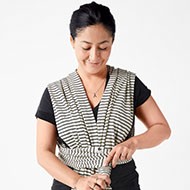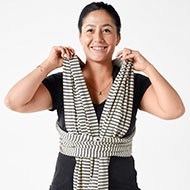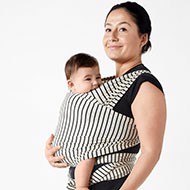How to use a Coracor baby wrap
When using your Coracor baby wrap for the first time, you will have an easier time if your baby is fed, well rested, and newly changed. This new routine can take a few attempts before it feels comfortable for you and your baby. Give it a few tries, things will fall into place sooner than you think. Please wash your baby wrap according to the wash instructions, before you use it for the first time.
Setting up

1. Locate the Coracor logo in the middle, and place it centered across your chest, aligned with your armpits. This is called the horizontal pass.

2. Cross the two ends behind your back and bring the ends up and over your shoulders, creating an "X" on your back. Keep the fabric flat so it doesn’t twist.

3. Gather both ends and tuck them under the horizontal pass on your chest, from the top down.

4. Tighten the wrap by pulling the fabric up and forward at the shoulders.

5. Cross the ends in the front to form an "X" across your chest, called the inner and outer diagonal passes. Make sure your wrap is nice and snug, especially the upper part of the horizontal pass.

6. Bring the ends behind your back and tie a double knot – at the back, on your hip, or at the front – tie it where your body type allows. If there’s any slack at the knot, move it to the cross at the front, to check whether it is enough room for your baby, or if you need to adjust your tightening.
Getting in

7. Hold the baby against the shoulder with the outer diagonal pass. Take your time to calm your baby if needed, and make sure the baby is fully supported.

8. Carefully slide your baby into the inner diagonal pass. Pull the soft stretchy fabric away from your body to easily insert your baby’s leg. Be careful not to overspread your baby’s knees. Spread the fabric evenly from one knee to the other, and cover the baby’s bottom, thighs, back and shoulders.

9. Spread the other pass over your baby’s body and to the back of the knees.

10. Gently put the baby’s legs through the horizontal pass and pull it up and over your baby’s back.
Getting out

1. To remove the baby from the wrap, pull down the horizontal pass below the baby’s bottom.


3. Carefully lift the baby straight up and out of the wrap. The wrap can be left in place ready for next time.
Safe for Sure
Wearing your baby in a wrap is a wonderful way to experience the world together. It is important to keep them safe, too. We recommend you keep a few things in mind whenever you are wearing your little one.
I see you. Always have a clear view of your baby and your baby's breathing. You should always be able to see your baby's face just by simply turning your eyes down. The wrap should never cover the face or restrict air flow. A good way to ensure air flow is to have a width of two fingers between the baby's chin and chest. Check on your baby so that it is not too hot or cold.
Safely seated. The baby should be placed in an upright, deep-seated, squat position, where the knees should be higher than the bottom, with the pelvis tilted towards you. Always support your baby's head until the baby can support itself. When bending or leaning, always support your baby's neck. Make sure your baby is securely positioned in the sling, to prevent hazards from falling. A simple way is to let go of your hands and check if you feel safe to be hands free when carrying.
I've got your back. The wrap should be tight to support both your back, and the baby's back and thighs (from knee to knee). The baby should be very close to you, in this way the carrying is comfortable and ergonomic for the both of you. You can check by placing your hand and gently pressing the baby's back, the baby should not be lifted or moved closer to you by this pressure. If the wrap is not tight enough, the baby can slump down, causing respiratory distress, or strain your back. Your baby should have a natural curved lower back when in the wrap. Make sure the fabric is smooth over the baby's back, and that the head is in alignment with the rest of the body.
Close enough to kiss. The baby's head should be as close to your chin as comfortable. Being able to kiss your baby on the top of the head, or forehead, when tilting your head slightly forward, is a simple way of determining the correct height. Remember to keep a small baby's hands close to their face.
We recommend that you check out the Circle of Safety by Ulrika Casselbrant, it's available to download as PDF

The Coracor baby wrap is developed according to the Swedish Standards Institute's safety guidelines for carrying one child. It is always your responsibility to use this product as recommended according to the safety guidelines, and to always keep your baby attended. For premature, low birth weight babies, and children with medical conditions, seek advice from a health professional before using this product. Coracor will not be held responsible for any injuries or damages due to misuse or careless babywearing.
- Be aware of your surroundings, try not to burn, scold or otherwise hurt yourself or your baby. Do not use the baby wrap when handling hot foods and beverages, and when standing near hot surfaces.
- Do not go to sleep while wearing your baby.
- Please keep in mind that your center of gravity is impacted by wearing your baby, and the baby’s movement may affect your balance.
- Adapt your level of activity, a baby wrap is not suitable for exercising in.
- When the baby becomes more active, its movements may increase the risk of falling out.
- Regularly check for signs of wear and damage, do not use the baby wrap if it is torn or damaged.
- Keep the baby wrap away from children when not in use, and away from fire at all times. The baby wrap is not a toy.

